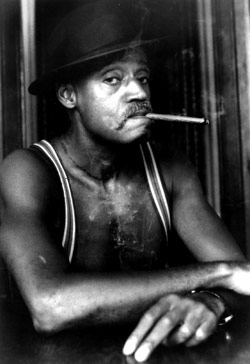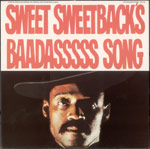Melvin Van Peebles and Blaxploitatioin

Melvin Van Peebles’
Sweet Sweetback’s Baadasssss Song
is universally acknowledged as the film that sparked the Blaxploitation
era in Hollywood. But Van Peebles—and his film—have a more complicated
relationship with the films and the movement that followed in its wake.
When
Sweetback came out in 1971 “black films” were few and far between. In 1969, Warner Bros. had released Gordon Parks’
The Learning Tree and Ossie Davis directed
Cotton Comes to Harlem that same year; Columbia Pictures brought out Van Peebles’s American debut,
The Watermelon Man, the following year (his first feature was the 1967 French film
La Permission
[a k a Story of a Three-Day Pass]). These films, however, sprang from
the prevailing Hollywood ethos of the day, their black stars and
directors notwithstanding (though
Watermelon Man showed traces of Van Peebles’s subversive nature, hinting at the cinematic explosion to come).
Sweet Sweetback’s Baadasssss Song
changed all that. Unable to find a studio to finance his 30-page ck
script, Van Peebles decided to go it alone. With a budget of $500,000
and a cast and crew made up largely of black and Hispanic
nonprofessionals, Van Peebles shot
Sweetback guerrilla-style
around L.A. over a 23-day period in May and June of 1970. Yet despite
the film’s low budget and the modest success of
The Watermelon Man,
Van Peebles could get no one to release his film. Finally, he found a
struggling distribution company on the verge of bankruptcy, which agreed
to Van Peebles’s demand for a 50% share once the movie grossed $5
million. The company, Cinemation, could only persuade two theaters to
show the film: the Grand Circus in Detroit, where the film premiered on
March 31, 1971, and the Coronet Theatre in Atlanta, where the film
opened two days later. That would soon change.

Smashing box-office records in both theaters, word spread like
wildfire through the black community, despite the fact that most
mainstream newspapers and magazines wouldn’t even review it. Soon, more
and more theaters across the country began booking the film. Van Peebles
helped to grease the promotional rails by devising two ingenious
marketing devices. The first was the simultaneous release of a
soundtrack album (written by Van Peebles and performed by Earth, Wind
and Fire—the first recording by the future R&B legends) that started
getting airplay on black radio stations, thereby ensuring that “Sweet
Sweetback’s Baadasssss Song” got mentioned every time a DJ dropped the
title track. The second big plug came as a result of the RIAA’s threat
to give the film an X rating—a reaction to the raw (and frequent) sex
depicted on the screen. So Van Peebles refused to submit the film for an
official rating, resulting in an automatic X. Flipping the script on
the ratings board, Van Peebles came up with the slogan “Rated X by an
all-white jury”—a phrase that found its way onto posters, ads, and
T-shirts and became a rallying cry for black audiences from coast to
coast. “Melvin was a great marketer,” director Spike Lee says in
How to Eat Your Watermelon in White Company (and Enjoy It). “They did him a favor by giving him an X rating. Whatever they did to him he turned into a positive.”
Elvis Mitchell goes even further. In the same documentary, the former critic for
The New York Times
says, “Melvin created a controversy. His career has been built around
that, about knowing how to make noise and making controversy work to his
advantage. He made himself Bobby Seale, Huey Newton and Eldridge
Cleaver all rolled into one.”
Clever marketing gimmicks
notwithstanding, the film’s success was ultimately due to its radical
nature. Quite simply, audiences—that is to say,
black
audiences—had never seen anything like it. The scenario couldn’t be
simpler: Sweet Sweetback (played by Van Peebles)—who was raised in an
L.A. brothel—performs as the star attraction in an underground sex club.
When the cops drop by to round up some individuals for a lineup,
Sweetback is sent downtown as the sacrificial lamb to keep the law off
their backs. En route to the station, the cops answer a call for a
disturbance—apparently some young community activist is stirring up
trouble. On the scene, the cops apprehend the young man and promptly
start kicking the hell out of him. His handcuffs loosened, Sweetback can
no longer stand by idly and watch his brother get beaten anymore. He
attacks the two cops, strangling them with the handcuffs, and the two
flee. And this is just the first five minutes—the rest of the film
details Sweetback’s efforts to escape the encroaching dragnet. It’s a
90-minute chase movie, as Sweetback is forced to use his wits (as it
were; this often entails him fucking his way out of trouble, literally!)
to survive. Which he does. And that was the shocker. Here was a movie
in which the black hero kills four white cops (two others would meet a
similar fate later)—and gets away with it! The film ends with a call to
arms, a title card stating: “This film is dedicated to all the brothers
and sisters who had enough of the Man.”
As the filmmaker St. Clair Bourne explains in
How to Eat Your Watermelon in White Company (and Enjoy It),
what seemed on the surface to be a simple action-adventure story, had
deep, penetrating cultural and social significance. “Melvin is
challenging, engaging core issues in American life. Issues that people
don’t even want to talk about. And then he does it in a way that’s not
simplistic. Here’s a guy [Sweetback] who kills a cop with his own
handcuffs—and says he’s right to do it.”
It was a message
that resonated loud and clear with Huey Newton, cofounder of the Black
Panther Party. After seeing the film, Newton devoted an entire issue of
the Party’s newspaper to the film, in which he contributed a lengthy
analysis of the film’s revolutionary qualities. He made
Sweetback required viewing for all Black Panther Party members. In
How to Eat Your Watermelon in White Company…, Billy “X” Jennings, Newton’s former assistant who currently runs the Panthers’ historical website,
itsabouttimebpp.com,
describes the effect the film had on Party members at the time. “It was
the embodiment of what the Party was about. Finally, we’d seen somebody
capture our thoughts, our gestures, our ideology…so when we saw that
projected on the screen, all it did was help to empower us even more:
‘Yeah, this time they finally got it right!’ ”
Black
audiences and the Black Panthers weren’t the only ones taking note of
the film’s success and power, however. As the film became a runaway hit
(at its time,
Sweet Sweetback’s Baadasssss Song was the highest-grossing independent film ever made), Hollywood came to a belated revelation: there’s an audience out there.
When MGM released
Shaft
in July of 1971, and the film became a huge hit—propelled in large part
by Isaac Hayes’s classic theme song—the floodgates were open.
(Interestingly, Melvin Van Peebles contends that
Shaft was originally written as a white detective story; that it was only changed following the success of
Sweetback,
a claim the film’s director, Gordon Parks, disputed in an interview
with filmmakers Joe Angio and Michael Solomon during the filming of
How to Eat Your Watermelon in White Company [and Enjoy It].) What followed was a torrent of black-themed studio films:
Superfly…
Coffy…
Blacula…
Black Caesar…and on and on and on. The Blaxploitation* era in Hollywood was in full effect.
But as filmmaker St. Clair Bourne contends in
How to Eat Your Watermelon in White Company (and Enjoy It), the studio suits had a different agenda in mind. “When Melvin made
Sweetback,
nobody could deny its power. But what happened was the classic American
process. Hollywood said, ‘Wow, a lot of people like this stuff. Let’s
take the formula for it, take out the politics, and give them a wave of
these films,’ and essentially, Blaxploitation is the bastard child of
Sweetback.”
Later in the same documentary, Van Peebles’s son, Mario, elaborates on this point. “[Hollywood] made
Shaft; they made
Superfly.
There was a chance for black actors to get work in leading-man roles.
But there was also something else going on. What they did was they
perverted the message. Bobby Rush, ex-Panther, Congressman Bobby Rush said to me, ‘One of the things your father’s film
Sweet Sweetback’s Baadasssss Song did was it made being a revolutionary hip. And the Panthers made being a revolutionary hip. But
Superfly made being a drug dealer hip.’ Big difference.
“That impact of
Superfly
and a lot of these movies did a lot of damage,” Mario Van Peebles
continues, “and eventually, if you make enough shark movies or enough
Vietnam movies, people will get tired of going to them, and what they
did, in this case, was they shut the economic doors in Hollywood, and
they said, well, they didn’t say ‘Those action-y movies aren’t making
money anymore;’ they said, ‘Those movies with those black people aren’t
making money anymore,’ so they shut the economic doors.”
By the end of the decade, the wellspring of black-themed films had
reduced to a trickle, before drying up completely, and the
Blaxploitation era in Hollywood died a silent, unceremonious death.
—Joe Angio, November 2006 *For
more on the origins of the term Blaxploitation and the Blaxploitation
era, read David Walker’s essay from the book What it Is…What it Was!,
edited by Gerald Martinez, Diana Martinez and Andres Chavez.)

 Melvin Van Peebles’ Sweet Sweetback’s Baadasssss Song
is universally acknowledged as the film that sparked the Blaxploitation
era in Hollywood. But Van Peebles—and his film—have a more complicated
relationship with the films and the movement that followed in its wake.
When Sweetback came out in 1971 “black films” were few and far between. In 1969, Warner Bros. had released Gordon Parks’ The Learning Tree and Ossie Davis directed Cotton Comes to Harlem that same year; Columbia Pictures brought out Van Peebles’s American debut, The Watermelon Man, the following year (his first feature was the 1967 French film La Permission
[a k a Story of a Three-Day Pass]). These films, however, sprang from
the prevailing Hollywood ethos of the day, their black stars and
directors notwithstanding (though Watermelon Man showed traces of Van Peebles’s subversive nature, hinting at the cinematic explosion to come).
Melvin Van Peebles’ Sweet Sweetback’s Baadasssss Song
is universally acknowledged as the film that sparked the Blaxploitation
era in Hollywood. But Van Peebles—and his film—have a more complicated
relationship with the films and the movement that followed in its wake.
When Sweetback came out in 1971 “black films” were few and far between. In 1969, Warner Bros. had released Gordon Parks’ The Learning Tree and Ossie Davis directed Cotton Comes to Harlem that same year; Columbia Pictures brought out Van Peebles’s American debut, The Watermelon Man, the following year (his first feature was the 1967 French film La Permission
[a k a Story of a Three-Day Pass]). These films, however, sprang from
the prevailing Hollywood ethos of the day, their black stars and
directors notwithstanding (though Watermelon Man showed traces of Van Peebles’s subversive nature, hinting at the cinematic explosion to come). Smashing box-office records in both theaters, word spread like
wildfire through the black community, despite the fact that most
mainstream newspapers and magazines wouldn’t even review it. Soon, more
and more theaters across the country began booking the film. Van Peebles
helped to grease the promotional rails by devising two ingenious
marketing devices. The first was the simultaneous release of a
soundtrack album (written by Van Peebles and performed by Earth, Wind
and Fire—the first recording by the future R&B legends) that started
getting airplay on black radio stations, thereby ensuring that “Sweet
Sweetback’s Baadasssss Song” got mentioned every time a DJ dropped the
title track. The second big plug came as a result of the RIAA’s threat
to give the film an X rating—a reaction to the raw (and frequent) sex
depicted on the screen. So Van Peebles refused to submit the film for an
official rating, resulting in an automatic X. Flipping the script on
the ratings board, Van Peebles came up with the slogan “Rated X by an
all-white jury”—a phrase that found its way onto posters, ads, and
T-shirts and became a rallying cry for black audiences from coast to
coast. “Melvin was a great marketer,” director Spike Lee says in How to Eat Your Watermelon in White Company (and Enjoy It). “They did him a favor by giving him an X rating. Whatever they did to him he turned into a positive.”
Smashing box-office records in both theaters, word spread like
wildfire through the black community, despite the fact that most
mainstream newspapers and magazines wouldn’t even review it. Soon, more
and more theaters across the country began booking the film. Van Peebles
helped to grease the promotional rails by devising two ingenious
marketing devices. The first was the simultaneous release of a
soundtrack album (written by Van Peebles and performed by Earth, Wind
and Fire—the first recording by the future R&B legends) that started
getting airplay on black radio stations, thereby ensuring that “Sweet
Sweetback’s Baadasssss Song” got mentioned every time a DJ dropped the
title track. The second big plug came as a result of the RIAA’s threat
to give the film an X rating—a reaction to the raw (and frequent) sex
depicted on the screen. So Van Peebles refused to submit the film for an
official rating, resulting in an automatic X. Flipping the script on
the ratings board, Van Peebles came up with the slogan “Rated X by an
all-white jury”—a phrase that found its way onto posters, ads, and
T-shirts and became a rallying cry for black audiences from coast to
coast. “Melvin was a great marketer,” director Spike Lee says in How to Eat Your Watermelon in White Company (and Enjoy It). “They did him a favor by giving him an X rating. Whatever they did to him he turned into a positive.”